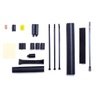In Stock, Same Day Shipping or Pickup:
The item is in stock and will usually ship the same day that your order is placed, as long as the order is placed Monday-Friday before 4 p.m. Central Time (2:30 p.m. Eastern Time for Canadian orders). This excludes holidays on which carrier service is not available. Large orders that will require freight service are excluded from same day shipping and will be shipped on the next business day. Orders placed after the shipping cutoff time will be processed on the next business day. Your credit card will not be charged until your order is shipped.
Alternatively, this item can be picked up directly from one of our local warehouses (Lake Zurich, IL in the US from 9 a.m. to 4 p.m. Central Time or Richmond Hill, ON in Canada from 9 a.m. to 4 p.m. Eastern Time). Available Monday-Friday except for holidays. Please allow 2 hours for processing.
Ships Next Business Day:
The item is in stock and will usually ship the next business day, after your order is placed, via LTL freight service—as long as the order is placed Monday-Friday before 4 p.m. Central Time (3 p.m. Eastern Time for Canadian orders). This excludes holidays on which carrier service is not available. Orders placed after the shipping cutoff time will be processed on the next business day. Your credit card will not be charged until your order is shipped.
Advance Order / Expected soon:
The item is currently being restocked and is available for advance order. "Expected soon" indicates inbound inventory is on the way (typically within 30 days). Place an advance order to reserve your unit and we will ship as soon as stock arrives. Call us at 800-875-5285 for a shipping-time estimate. Your credit card will not be charged until your order is ready to ship (except for custom made products).
Oversized Shipping:
The item is considered oversized and might require LTL freight service. Free shipping promotions might not apply to this class of item.
For additional information, please visit our Detailed Shipping Policy and Return Policy.













